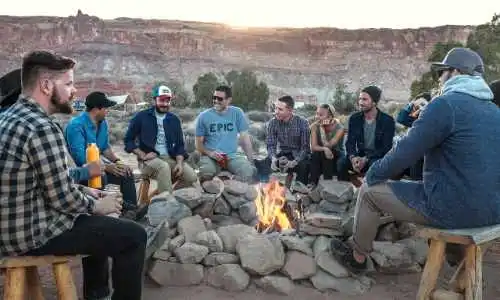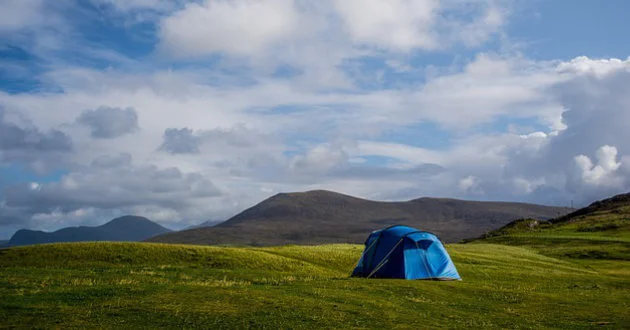Greetings, fellow outdoor enthusiasts,
Today, we will discuss a topic of utmost importance when embarking on a camping trip – keeping your food cold when camping. As someone who has spent countless nights in the great outdoors, I can attest that having properly chilled food can make or break a camping experience. In this post, I will share my tips and tricks for keeping your camping food cold and fresh for the duration of your trip.
Keeping Food Cold When Camping
First and foremost, it is essential to understand why keeping your food cold when camping is so crucial. Bacteria thrive in warm environments, meaning food left at room temperature or above is susceptible to spoilage and can cause food poisoning.
Foodborne illnesses caused by consuming camping food that has not been kept cold can be a severe health risk. When food is not stored at the proper temperature, bacteria can grow rapidly, leading to food poisoning.
The most common symptoms of foodborne illness include diarrhoea, vomiting, fever, and abdominal pain. These symptoms can be particularly dangerous for individuals with weakened immune systems, such as young children and elderly people.
To prevent foodborne illness while camping, it’s important to keep all perishable food items in a cooler with plenty of ice or freezer packs, and to avoid leaving food out in the sun for extended periods of time.
Keeping food cold when camping is very important, as medical assistance may not always be readily available. In addition to safety concerns, no one wants to bite into a warm, soggy sandwich or a wilted salad after a long day of hiking. By keeping your food cold, you ensure not only its safety but also its quality.
Now, onto the practical tips.

Tips for Keeping Camping Food Cold
The first step in keeping your food cold when camping is selecting a suitable cooler. A high-quality cooler is an investment that will pay off in the long run. Look for a well-insulated cooler with an excellent seal to keep cool air in and warm air out.
A thicker, sturdier cooler is better able to withstand the wear and tear of camping trips and will keep your food colder for longer.
Consider investing in a cooler with wheels if you plan on carrying a lot of food, as this will make it easier to transport from your car to your campsite.
Once you have your cooler, the next step is to prepare your food for storage properly.
Preparing Food For Storage When Camping
Pre-chilling your food is a great way to keep it cold for longer. This means putting your food in the refrigerator or freezer before you leave for your trip. If you are using frozen foods, it is best to let them thaw slowly in the refrigerator rather than at room temperature. This will ensure that your food stays at a safe temperature and also prevents ice crystals from forming, which can affect the texture of your food.
When packing your cooler, it is vital to keep certain foods separate to avoid cross-contamination. Raw meat and fish should always be kept in a separate container or plastic bag to prevent the juices from leaking onto other foods.
It is also important to keep perishable items like dairy, eggs, and meat towards the bottom of the cooler, where it is coldest. This will help prevent these items from spoiling too quickly.
To learn more about which food to bring, read my recommendations on what food keeps well for camping.
Another important aspect of keeping your food cold is to keep the cooler out of direct sunlight. Placing your cooler in the shade or covering it with a blanket or tarp can help keep the temperature inside the cooler down.
Opening and closing the cooler frequently can also cause the temperature inside to fluctuate, so try to limit the number of times you open the cooler.
To further extend the life of your ice, consider freezing some of your food items before placing them in the cooler. This will help keep the food cold and act as an additional source of ice to keep the rest of your food chilled.
Alternatively, you can use frozen water bottles or ice packs to keep your cooler cold. These items can be placed in the freezer before your trip and then used to chill your food once you arrive at your campsite.
If you plan on camping for an extended period of time, it is crucial to replenish your ice supply. This can be done by purchasing ice at a nearby store or making your own ice blocks at home. Simply fill up a large container with water and freeze it before your trip. These large ice blocks will last longer than smaller ice cubes and can help keep your food cold for several days.
In addition to using ice, you can use a few other hacks to keep your food cold while camping.
One of my favourites is to use frozen vegetables as a way to keep your cooler cold. By placing frozen bags of vegetables in your cooler, you can add an extra layer of insulation that will help keep your food cold for longer. Plus, you’ll have a healthy snack option on hand as well!
Another hack is to use dry ice. Dry ice is frozen carbon dioxide and is much colder than regular ice. While it can be more expensive than traditional ice, it can keep your food cold for several days and doesn’t melt, leaving your food dry and free from waterlogged packaging.
However, handling dry ice with care is vital, as it can be dangerous if mishandled.
Finally, cleaning your cooler regularly is essential to prevent any bacteria buildup. Once you return from your camping trip, be sure to empty the cooler and clean it thoroughly with soap and water. Wipe down the interior and exterior with a disinfectant and let it air dry before storing it away for your next trip.
Types of Coolers for Camping
When it comes to camping, one of the essential items you’ll need is a cooler to keep your food and drinks cold. But not all coolers are created equal, and there are a variety of types to choose from depending on your needs.
First, there’s the classic hard-sided cooler. These are the heavy-duty coolers that you’ve probably seen at tailgate parties and camping trips. They’re great for keeping food cold for several days; some can even keep ice frozen for up to a week. However, they’re also heavy and bulky, which can be a challenge if you’re trying to pack light.
If you’re looking for something a bit more portable, consider a soft-sided cooler. These are lightweight and easy to carry, making them a great choice for hiking or backpacking trips. They’re not as effective at keeping things cold as their hard-sided counterparts, but they’re still a good option for short trips.
For the ultimate in portability, there are also collapsible coolers. These are made of lightweight materials and can be folded up when not in use, making them easy to store in your pack or car trunk. They’re not as durable as other types of coolers, but they’re a great choice if you’re short on space.
No matter what type of cooler you choose, be sure to invest in a high-quality model that will keep your food and drinks cold and fresh throughout your camping trip.
In conclusion, keeping your camping food cold is crucial for both safety and enjoyment. By selecting a suitable cooler, properly preparing your food, and using ice and other hacks to keep it chilled, you can ensure that your food stays fresh for the duration of your trip.
Remember to keep your cooler out of direct sunlight, replenish your ice supply, and clean your cooler regularly to prevent any bacteria buildup. With these tips in mind, you can enjoy delicious, chilled meals during your camping adventure.
Happy camping!
"Outdoor Personal Chef" participe au programme Amazon Services LLC Associates Program, un programme de publicité d'affiliation conçu pour fournir un moyen aux sites de gagner des frais de publicité en faisant de la publicité et en établissant des liens vers Amazon.com. Nous participons également à d'autres programmes d'affiliation qui nous rémunèrent pour le trafic que nous référons.

